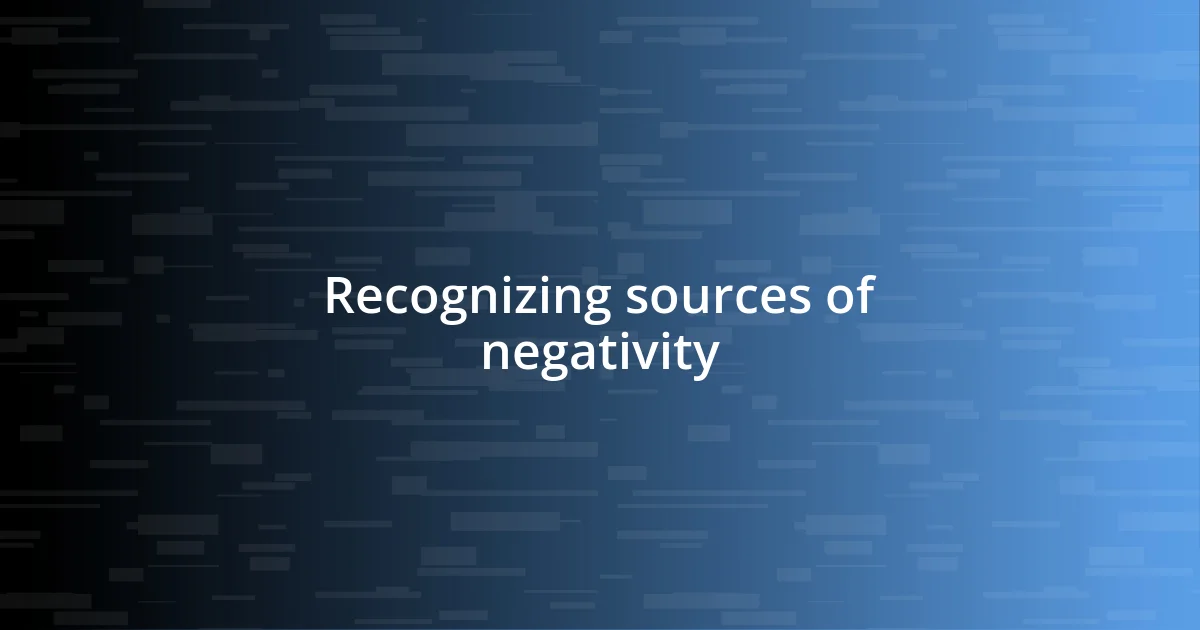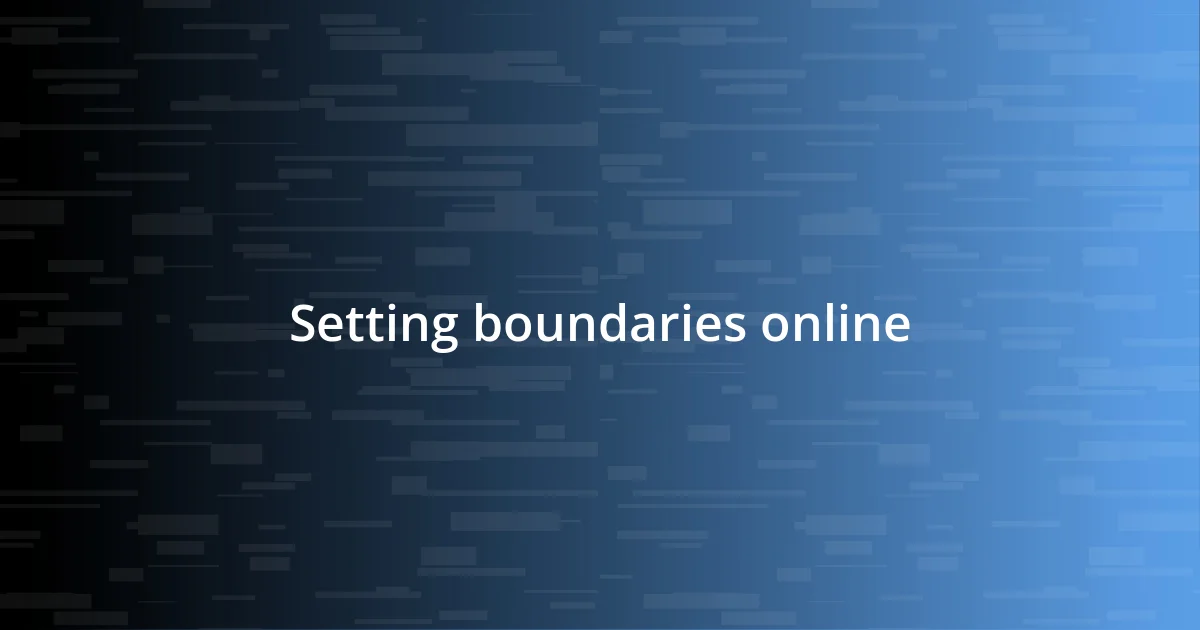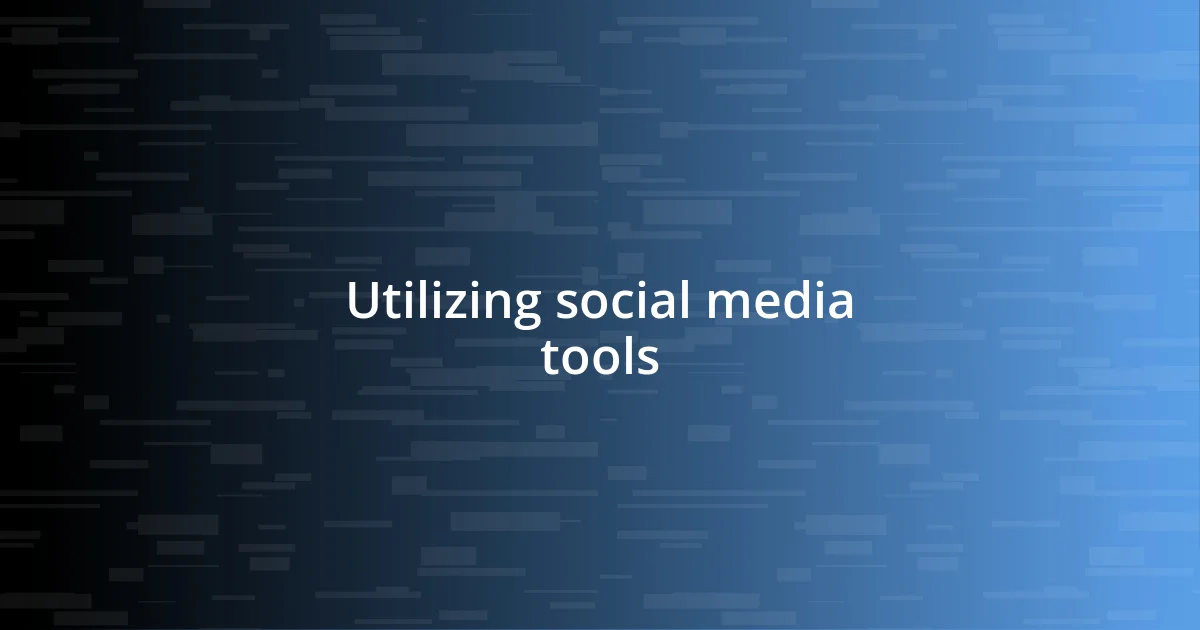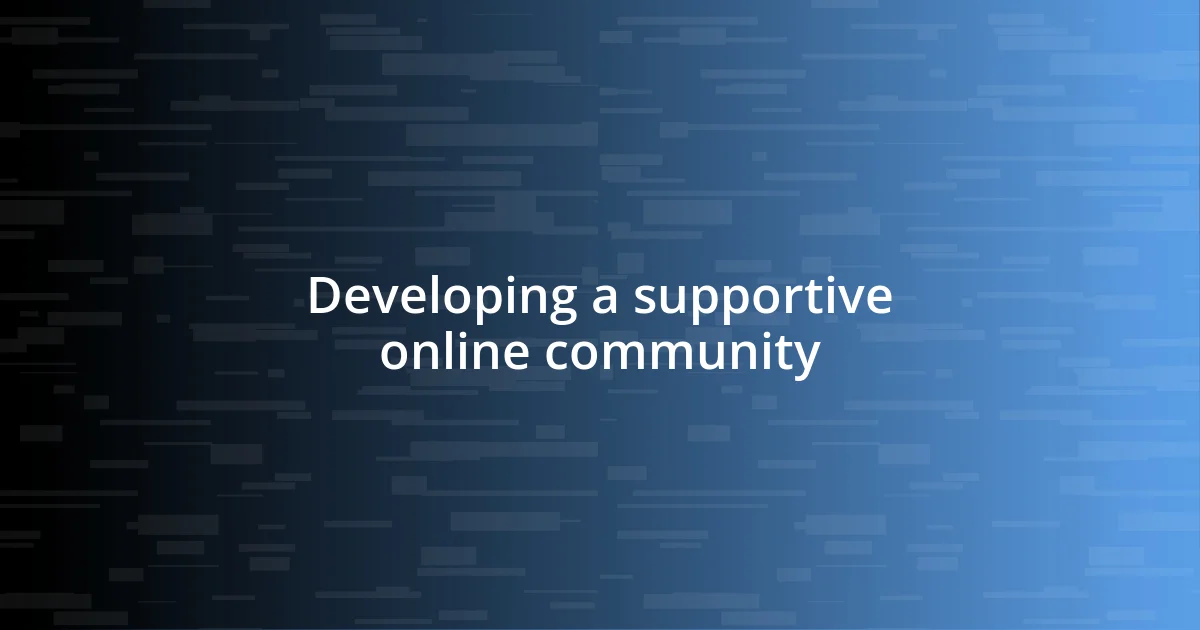Key takeaways:
- Online negativity often stems from anonymity, personal frustrations, and echo chambers, leading to a lack of connection and empathy in digital interactions.
- Setting boundaries—like muting toxic conversations, limiting engagement with negative content, and actively curating social media feeds—can significantly enhance mental well-being and foster a more positive online environment.
- Building a supportive online community through intentional engagement and practices, like gratitude threads, can create a nurturing atmosphere and promote kindness and understanding among members.

Understanding online negativity
Understanding online negativity can be an overwhelming experience. I remember scrolling through social media one evening, coming across a heated debate in the comments section. It struck me how quickly a simple opinion could spiral into personal attacks, leaving everyone involved feeling drained. Why do we feel compelled to lash out from behind a screen?
It often feels like negativity online is amplified by anonymity; people say things they wouldn’t dare express in person. I’ve found myself questioning the motivations behind these harsh comments. Are people projecting their frustrations? When faced with negativity, I’ve started to consider the emotional state of the person behind the keyboard rather than just the message.
Over time, I realized that much of online negativity stems from a lack of connection. During a particularly tough week, I caught myself engaging with a negative comment, and it only fueled my stress. It made me wonder, how can we navigate these turbulent waters when so many are looking for a place to vent? Recognizing that many individuals are navigating their own struggles helped me develop compassion rather than anger, shifting my experience online.

Recognizing sources of negativity
It’s essential to identify where negativity is coming from in our online interactions. I’ve noticed that social media platforms often create an echo chamber effect, where negative opinions gain traction quickly. This realization hit me during a group chat among friends who started out discussing a film but veered into criticizing individuals in the film industry. Their shared negativity created a palpable shift in the group’s mood, highlighting how easily we can fall into a cycle of disdain.
One particularly impactful moment for me was when I stumbled upon a comment section filled with harsh judgments about a local business. I felt anger bubbling up but paused to consider—what drove these commenters to express such vitriol? It dawned on me that many were likely grappling with their frustrations about personal or financial challenges. I began to recognize that behind every negative comment could be an untold story, which shifted my perspective from judgment to empathy.
Over time, I learned to tune in to the common themes of negativity. Whether it’s jealousy, anger, or plain old misunderstandings, recognizing these patterns allows me to disengage from toxic discussions. I’ve started to filter my social media feeds actively, choosing to follow accounts that promote positivity and constructiveness instead. This change has significantly enhanced my online experience, proving to me that while negativity is pervasive, I have the power to cultivate my environment.
| Source of Negativity | Characteristics |
|---|---|
| Anonymity | Encourages harsh words, shields from accountability |
| Echo Chambers | Reinforces negative attitudes within similar viewpoints |
| Personal Frustrations | Often project personal issues onto public forums |

Setting boundaries online
Setting boundaries online is a crucial step in managing the negativity that can invade our digital spaces. In my experience, I’ve found that clarity about what I am willing to engage with can protect my mental well-being. For instance, I once decided to mute certain conversations in group chats that had become consistently critical and toxic. It was surprising how much lighter I felt, knowing I could still be part of the group without absorbing all that negative energy.
Here are some practical boundaries I’ve set that you might consider implementing:
- Limit Interaction: Only engage with content that uplifts or informs you.
- Adjust Notifications: Silence notifications from apps that tend to generate negativity.
- Curate Your Feed: Regularly review and unfollow accounts that drain your energy.
- Set Time Limits: Allocate specific times for social media, and stick to them.
- Use Block/Mute Features: Don’t hesitate to block or mute negative accounts or individuals.
Before I made these changes, I felt overwhelmed, like I was drowning in a sea of harsh comments and heated debates. Now, by actively setting these boundaries, I cultivate a more positive online atmosphere that reflects my values and keeps negativity at bay.

Practicing positive online interactions
Practicing positive online interactions often begins with a conscious choice to engage differently. I remember a time when I joined an online forum to discuss a hobby I love. Instead of just absorbing the conversations, I made it a point to contribute positively, whether it was sharing a helpful tip or complimenting others’ contributions. This shift not only enriched my experience but also encouraged others to interact more kindly. Isn’t it fascinating how a little positivity can ripple out, uplifting the entire community?
I’ve also found that actively acknowledging and appreciating kindness online can have a profound impact. Just a few weeks ago, I came across a heartfelt post from someone sharing their struggles with mental health. Rather than scrolling past, I took a moment to leave a supportive comment. That single action sparked a thread of encouragement that resonated throughout the comment section. It felt rewarding, like I was part of something bigger. Have you ever considered that your words might be the light someone needs in their day?
Furthermore, I try to steer clear of dry, fiery debates that lead to nowhere but frustration. During a recent political discussion, I noticed how quickly it escalated. Instead of engaging in the back-and-forth, I suggested we focus on shared values instead of differences. Surprisingly, this approach quelled the tension and opened up a dialogue where everyone shared their perspectives thoughtfully. It’s a reminder that we can choose to build bridges rather than walls if we genuinely seek connection.

Utilizing social media tools
Utilizing social media tools
Using social media tools effectively can be a game-changer in navigating negativity. I often rely on the “mute” function, which allows me to maintain a connection without subjecting myself to unwanted negativity. For example, I once muted a friend who frequently shared heated political posts that became quite stressful. It felt like taking a breath of fresh air — I could still show my support when it mattered without the daily noise of arguments cluttering my feed.
Another tool I find helpful is the “favorites” or “save” feature on platforms like Instagram. I tend to curate a collection of inspiring posts or accounts that resonate with my values. Whenever I’m feeling down or overwhelmed, I revisit these saved gems for a little boost. Isn’t it amazing how revisiting positivity can shift your mood? Just last week, I scrolled through my favorites during a particularly tough day, and those affirming messages reminded me of the goodness still present online.
Lastly, I’ve learned to embrace social media analytics — yes, even for personal accounts! Tracking my engagement has shown me which content lifts my spirits and what tends to drain my energy. When I noticed that posts focusing on wellness and community sparked joy and engagement, I made it a point to interact and create more of that content. Have you ever considered tracking what truly resonates with you? It could lead to a more fulfilling online experience, transforming your social media from a source of stress into a comforting retreat.

Developing a supportive online community
Building a supportive online community requires intentional effort. I remember joining a group dedicated to crafting, where members openly shared their projects and struggles. It felt like a warm hug; the encouragement and constructive feedback I received inspired me to push my creative limits. Have you ever found a place like that where you genuinely felt you belonged?
Creating a positive atmosphere is not just about the content shared but also how we communicate. In another community I participated in, they launched a weekly “gratitude thread” where everyone posted something they appreciated about another member. I was amazed at how this simple practice not only deepened connections but also fostered a culture of appreciation. It makes me wonder: what simple act can you introduce in your own online circles to uplift others?
Moreover, I’ve observed that moderating discussions respectfully plays a significant role in maintaining a supportive environment. I recall a time when a heated disagreement nearly escalated during a live chat. Instead of letting it derail the conversation, a moderator stepped in and guided the dialogue back to a productive level. That moment taught me that with a little care, we can steer conversations towards understanding rather than division. Wouldn’t it be incredible if each of us took on that responsibility to keep our friendships—both online and offline—cultivated and harmonious?

Reflecting on your online experience
Reflecting on my online experience has become an essential practice for navigating negativity. There was a time when I mindlessly scrolled through my feeds, absorbing everything, good or bad, without considering how it affected my mood. One evening, after a long day, I found myself feeling drained and anxious, only to realize that the stress came from engaging with posts that seemed to fuel my worries. Since then, I’ve made it a habit to pause and ask myself: Are these interactions enriching my life?
I like to take a moment to evaluate the accounts I follow regularly. This self-reflection has led me to unfollow accounts that contribute to my feelings of comparison or inadequacy. I remember when I decided to unfollow a popular lifestyle influencer whose seemingly perfect life left me feeling less than. By letting go of that constant comparison, I found a newfound sense of freedom. Have you ever noticed how liberating it feels to curate your own digital space?
Looking back, it’s fascinating to see how my emotional landscape shifts based on what I choose to engage with online. Recently, I started jotting down my feelings before and after scrolling through social media. It’s surprising to see the correlation between mindful engagement and a more balanced emotional state. This simple act of reflection has encouraged me to cultivate a more positive online presence that not only uplifts me but also those around me. What insights might you discover when you take the time to reflect on your online interactions?














